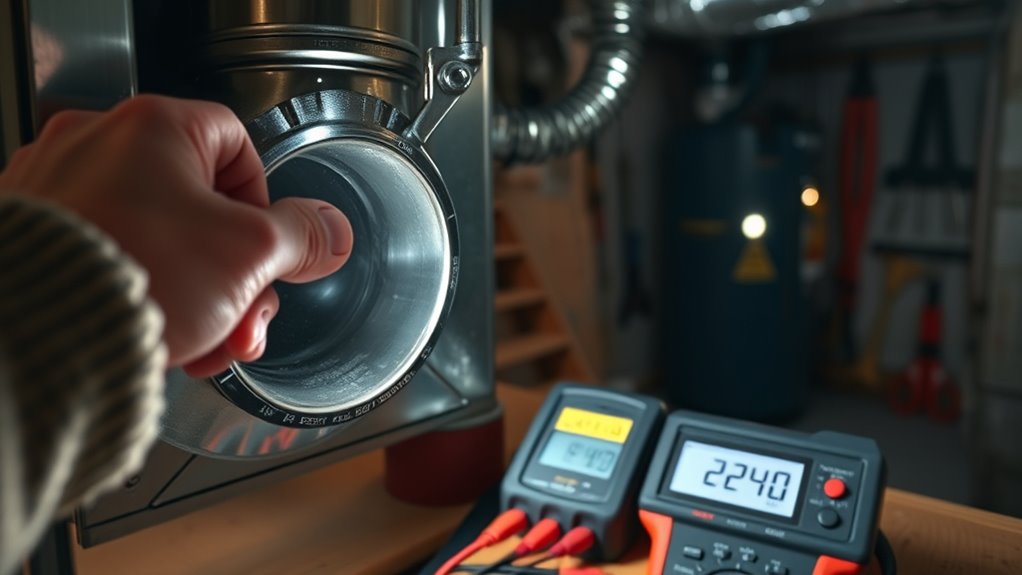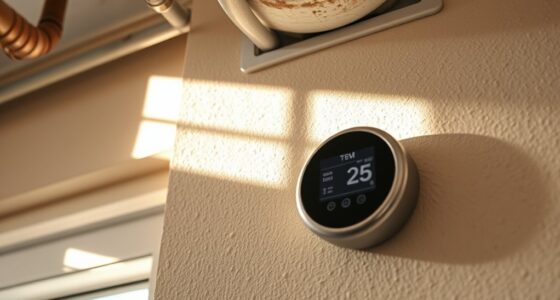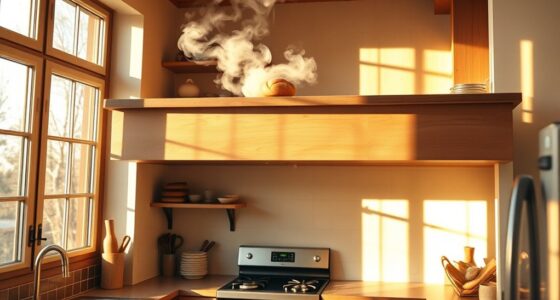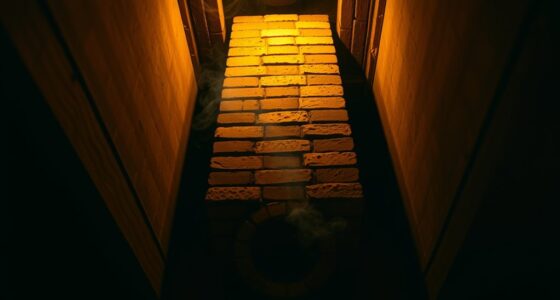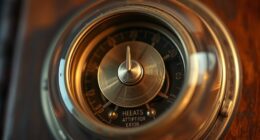If your furnace is short cycling, start by checking your thermostat settings and placement, making sure it’s accurate and away from drafts or heat sources. Next, inspect and replace any clogged filters and ensure vents are open and clear of obstructions. These simple fixes often resolve the issue quickly. If problems persist, there are other common causes to explore. Keep going for more tips that can help you troubleshoot effectively.
Key Takeaways
- Verify the thermostat is properly calibrated and placed away from drafts or heat sources.
- Check and replace dirty or clogged air filters to ensure unobstructed airflow.
- Inspect vents and ductwork for blockages or kinks that restrict airflow.
- Reset or test the thermostat for accurate temperature readings.
- If simple checks don’t resolve the issue, consult an HVAC professional for further diagnosis.
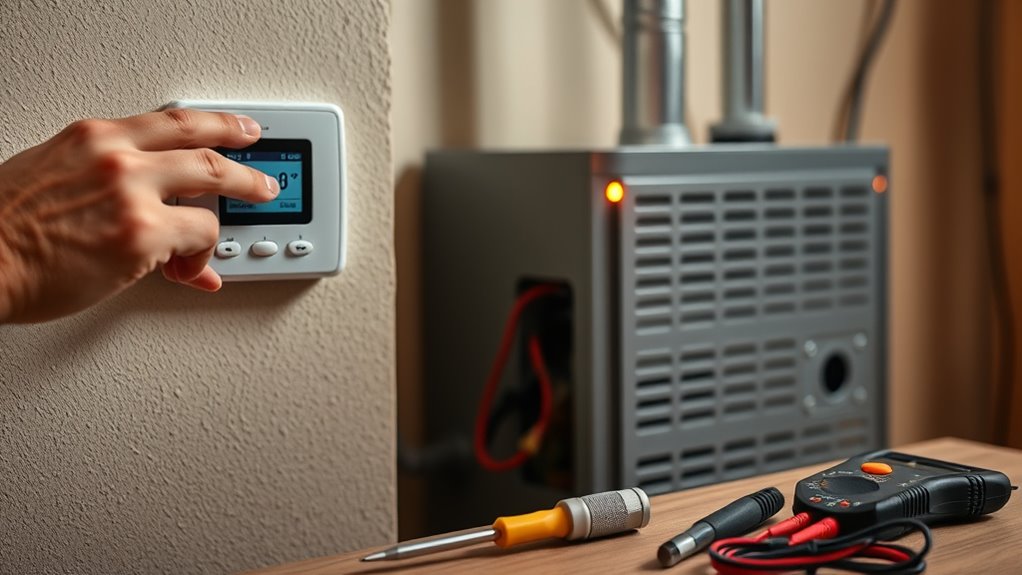
Ever wonder why your furnace keeps turning on and off unexpectedly? That’s a classic sign of short cycling, and it can be frustrating and costly if not addressed quickly. The good news is, some of the most common causes are straightforward to diagnose, especially if you start with a few quick checks. One of the first things to examine is your thermostat calibration. If your thermostat isn’t reading the temperature correctly, it might be telling your furnace to turn off prematurely or turn on too often. Sometimes, a simple recalibration or replacement of the thermostat can solve the problem. Make sure it’s placed away from drafts, direct sunlight, or heat sources, which can skew its readings. If your thermostat is old or malfunctioning, replacing it with a modern, digital model can restore proper temperature regulation and eliminate unnecessary short cycles.
Another common culprit is airflow obstruction, which can cause your furnace to overheat and shut off prematurely. Dust, debris, or even a clogged filter can restrict the airflow around your system. When airflow is blocked, the heat exchanger can get too hot, triggering the safety switch that turns the furnace off to prevent damage. Regularly inspecting and replacing your air filters is a simple yet effective way to prevent airflow issues. Also, check your vents and registers to ensure they’re open and unobstructed. If your ductwork is clogged or kinked, it can lead to uneven airflow, causing your furnace to cycle on and off repeatedly. Clearing any blockages and ensuring good airflow throughout your home helps your furnace operate more efficiently and reduces the risk of short cycling.
Sometimes, these quick checks reveal the root of the problem, but other times, more advanced issues like a malfunctioning limit switch or problems with the blower motor may be causing the short cycles. However, starting with thermostat calibration and airflow obstruction is a smart move because they’re common, easy fixes that can often restore normal furnace operation. Remember, regular maintenance, including cleaning filters and inspecting vents, goes a long way in preventing short cycling. If these simple steps don’t resolve the issue, it’s wise to call a professional HVAC technician, who can perform a thorough diagnosis and ensure your furnace runs smoothly and efficiently. Taking prompt action not only saves you money on energy bills but also prolongs the lifespan of your heating system.
Frequently Asked Questions
How Long Should a Furnace Run Before Shutting Off?
A furnace should run for about 15 to 20 minutes before shutting off, allowing proper heating and efficiency. If it short cycles frequently, check your thermostat calibration to ensure accurate temperature control. Also, inspect duct sealing to prevent heat loss, which can cause the furnace to turn on and off repeatedly. Proper calibration and sealed ducts help maintain consistent operation, reducing short cycling and improving comfort.
Can Thermostat Placement Cause Short Cycling?
Think of your thermostat placement like a judge in a courtroom—if it’s in the wrong spot, it can give false readings. If your thermostat is near airflow obstruction or in direct sunlight, it can cause short cycling, making your furnace turn on and off too quickly. Make certain it’s mounted on an interior wall, away from vents, drafts, or heat sources to keep your system running smoothly.
Is Short Cycling Dangerous for My Furnace?
Short cycling isn’t usually dangerous for your furnace, but it can hurt its efficiency and increase energy consumption. When your furnace keeps turning on and off quickly, it’s working harder than necessary, which wastes energy and raises your bills. Over time, this strain can cause wear and tear, potentially leading to more costly repairs. Addressing short cycling promptly helps improve your furnace’s performance, saving you money and extending its lifespan.
How Often Should I Schedule Furnace Maintenance?
Think of your furnace as a well-tuned orchestra; regular maintenance keeps everything harmony. You should schedule furnace maintenance annually to guarantee peak efficiency and catch issues early. These troubleshooting tips help prevent short cycling, saving energy and extending your furnace’s lifespan. Regular check-ups mean fewer surprises and a warmer home. Don’t wait for problems to escalate—stay ahead with consistent maintenance, and your furnace will perform like a melody, smooth and steady.
What Are Signs of a Failing Furnace Component?
If your furnace component is failing, you might notice inconsistent heating, strange noises, or frequent cycling. Check your furnace filter—if it’s clogged, it can cause the system to overwork. Also, look for vent blockage, which restricts airflow and stresses components. These signs indicate a failing part that needs attention. Regular maintenance helps catch issues early, preventing costly repairs and keeping your furnace running smoothly.
Conclusion
So, next time your furnace decides to rehearse its own version of a rollercoaster, remember these quick checks. Because who needs consistent warmth when you can have a dramatic, short-circuiting performance instead? Sure, troubleshooting might not cure your winter blues, but at least you’ll have a reason to call in the pros—unless you enjoy playing HVAC detective. Either way, stay warm, stay sane, and maybe invest in a good blanket—just in case.
